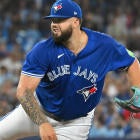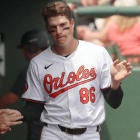Real baseball isn't played on a level field. Big-market teams often have the luxury of snapping up the biggest stars, while small-market teams have to be a little wily in order to compete. By contrast, Fantasy auctions allow all owners to start off with the same budget, but that doesn't mean they can't play their own version of "Moneyball."
While no owner has to overcome a massive deficit in financial resources when they come to the auction table, if they don't find a way to maximize the value they get from their budget, they won't enjoy the sweet taste of "Yoohoo" at the end of the season. As in the real game, part of finding value is identifying players who are undervalued and underappreciated by most other owners. Everyone has their method for finding sleepers and hidden gems; for years, I have relied on the method developed by Ron Shandler that views players through the lens of skill indicators (i.e., strikeout and walk rates, both for pitchers and batters) rather than through surface stats like batting average or ERA. Whichever tools you prefer, it's important to come prepared with a long list of players whom you expect to get on the cheap.
Value is also about supply and demand and timing. While every auction is somewhat unique, a general pattern that I have observed is that in the early going when the supply of viable players is greatest, owners get some of the biggest bargains. (However, you don't always want to go cheap in the early portion of the auction, and I'll explain why below.) A successful auction, then, not only depends on knowing which players you want to target but also knowing when to make your move.
It's not always clear as to when is a good time to break out your wallet, but these four strategies can at least give you some guidance on when to pull the trigger on bidding the extra dollar or making a nomination. There is not just one way to have a successful auction, so this is far from a comprehensive list of time-tested strategies, but they comprise a method that has worked for me.
1. Go a little extra on elite talent
However much you think you want to spend on particular players, when it comes to players who are far ahead of the field at their position, spend a little bit more. For example, when Joey Votto is nominated in an NL-only draft, it's worth your while to go as much as $10 over your budget for him. Not only can you practically be assured that Votto will perform at a very high level, but there is no one else in the NL who is likely to come anywhere near that level at his position. The same logic holds for Miguel Cabrera (in any format), Ryan Braun (in any format), Matt Kemp (in any format), Clayton Kershaw (in any format), Justin Verlander (in any format), Craig Kimbrel (in all Rotisserie formats), Jose Reyes (in AL-only leagues) and Buster Posey (in NL-only leagues). Some may feel comfortable adding Mike Trout to this list as well, though his limited track record would prevent me from going more than a few dollars over budget on him.
The key to making this strategy work is to find sleepers either in the early or late portions of the auction. Once you have anchored your roster with two or three high-priced elites, you can make up some of the budget deficit you've created by targeting players whom you perceive that other owners are undervaluing. A scan of our current average draft position rankings can give you a good sense of which players are generally being undervalued.
2. Come prepared with a list of sleepers you can get cheap, either early or late
To make your aggressive approach with elite players work, you will need to come prepared with a list of players whom you think you can win with bids that are below your budget for them. This list should be deep enough, so that if you either miss out on some of them or you underestimate others' interest in them, you have a Plan B. Not only do you need to be ready with a long list of names, but you need to start pursuing them -- nominating them, if necessary -- either in the early going or late. In the middle of the auction, the tiers of quality players start to thin out, and this is where many owners will wind up going over budget. Middle-tier players like Freddie Freeman, Aaron Hill or Pedro Alvarez often represent the last acceptable option remaining on the board, so it's easy to go a few extra dollars on them despite your best intentions. If you think these players could bring you good value in the early going when there is less of a mood of desperation, toss them out for nomination.
3. Let other owners outspend you during the middle portion of the auction
If you execute the first two strategies, you will probably enter the middle portion of the auction with one of the smaller remaining budgets. While it may be tempting to fill in the rest of your roster while there are still some solid players left to be taken, for the most part, this is a good time to sit back and watch the other owners empty their accounts. That is not to say that you should sleep on this portion of the auction, as you still have to be on the lookout for potential bargains. It's just that they could be much harder to find, so you need to resist the urge to get in a bidding war over middle-tier types. Make the occasional exception if you need to, but the overall theme of this portion of the auction should be restraint.
4. Mix up your nomination patterns
As mentioned above, sometimes you will need to nominate potential bargain players early, so that you maximize the chance that they remain bargains. However, you don't want to telegraph your intentions when you make a nomination. Use a variety of methods in selecting a nominee. On some occasions, you can scan the remaining options at a position that you've already filled and select the player who you think will go for the greatest value, thus taking some dollars out of the draft room. Other times you can throw out a player you'd like to have for $1, but one you're not attached to so that you won't feel the need to counterbid if someone goes $2 on him. Other times, just make a random selection.
Stay in touch with the most passionate Fantasy staff in the business by following us on Twitter @CBSFantasyBB or Al Melchior at @almelccbs . You can also e-mail us at fantasybaseball@cbsinteractive.com .





















